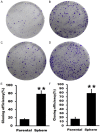Enrichment and characterization of cancer stem-like cells in ultra-low concentration of serum and non-adhesive culture system
- PMID: 29887968
- PMCID: PMC5992539
Enrichment and characterization of cancer stem-like cells in ultra-low concentration of serum and non-adhesive culture system
Erratum in
-
Erratum: Enrichment and characterization of cancer stem-like cells in ultra-low concentration of serum and non-adhesive culture system.Am J Transl Res. 2020 May 15;12(5):2319-2320. eCollection 2020. Am J Transl Res. 2020. PMID: 32509222 Free PMC article.
Abstract
Cancer stem cells (CSCs) play important roles in tumor initiation, metastasis, and progression. They are also mainly responsible for high treatment failure rates. Identification and characterization of CSCs are crucial for facilitating the detection, prevention, or therapy of cancer. Great efforts have been paid to develop an effective method and the ideal method for CSCs research is still in the going. In our study, we created an ultra-low concentration of serum and non-adhesive (ULCSN) culture system to enrich CSCs from murine lewis lung cancer cell line LL/2 with cell spheres structure and characterize the LL/2 CSCs properties. Their characteristics were investigated through colony formation, spheres formation, chemoresistance, flow cytometry for putative stem cell markers, such as CD133, CD34 and CD45, immunofluorescence staining and tumor initiation capacity in vivo. Tumor spheres were formed within 7-10 days under the condition of ULCSN culture system. Compared with adherent parental LL/2 cells, the colony capacity, chemo-resistance, and expression of stem cell markers increased significantly in addition to tumor-initiating capability in the tumor sphere cells. Using the ULCSN culture system, an available isolation method of lewis lung CSCs was established, which is simple, effective, and inexpensive compared with the cytokines attachment serum free culture method. The stem cell properties of the tumor sphere LL/2 cells reflected the CSCs phenotypes. We developed a useful CSCs model for basic and pre-clinical studies for lung cancer and other types of cancer.
Keywords: Cancer stem cells; cancer; characterization; marker.
Conflict of interest statement
None.
Figures






Similar articles
-
Enrichment and characterization of cancer stem‑like cells from a cervical cancer cell line.Mol Med Rep. 2014 Jun;9(6):2117-23. doi: 10.3892/mmr.2014.2063. Epub 2014 Mar 20. Mol Med Rep. 2014. PMID: 24676900 Free PMC article.
-
Development of a novel and economical agar-based non-adherent three-dimensional culture method for enrichment of cancer stem-like cells.Stem Cell Res Ther. 2018 Sep 26;9(1):243. doi: 10.1186/s13287-018-0987-x. Stem Cell Res Ther. 2018. PMID: 30257704 Free PMC article.
-
Nonadhesive culture system as a model of rapid sphere formation with cancer stem cell properties.PLoS One. 2012;7(2):e31864. doi: 10.1371/journal.pone.0031864. Epub 2012 Feb 16. PLoS One. 2012. PMID: 22359637 Free PMC article.
-
Cancer stem cells (CSCs), cervical CSCs and targeted therapies.Oncotarget. 2017 May 23;8(21):35351-35367. doi: 10.18632/oncotarget.10169. Oncotarget. 2017. PMID: 27343550 Free PMC article. Review.
-
Reporter gene systems for the identification and characterization of cancer stem cells.World J Stem Cells. 2021 Jul 26;13(7):861-876. doi: 10.4252/wjsc.v13.i7.861. World J Stem Cells. 2021. PMID: 34367481 Free PMC article. Review.
Cited by
-
Morphological and molecular characteristics of spheroid formation in HT-29 and Caco-2 colorectal cancer cell lines.Cancer Cell Int. 2021 Apr 13;21(1):204. doi: 10.1186/s12935-021-01898-9. Cancer Cell Int. 2021. PMID: 33849536 Free PMC article.
-
Evidence that cervical cancer cells cultured as tumorspheres maintain high CD73 expression and increase their protumor characteristics through TGF-β production.Cell Biochem Funct. 2022 Oct;40(7):760-772. doi: 10.1002/cbf.3742. Epub 2022 Sep 7. Cell Biochem Funct. 2022. PMID: 36070413 Free PMC article.
-
The Enrichment of Breast Cancer Stem Cells from MCF7 Breast Cancer Cell Line Using Spheroid Culture Technique.Methods Mol Biol. 2022;2429:475-484. doi: 10.1007/978-1-0716-1979-7_32. Methods Mol Biol. 2022. PMID: 35507182
-
Lung Cancer Stem Cells and Their Clinical Implications.Cold Spring Harb Perspect Med. 2022 May 17;12(4):a041270. doi: 10.1101/cshperspect.a041270. Cold Spring Harb Perspect Med. 2022. PMID: 34580078 Free PMC article. Review.
-
Androgen Receptor, Although Not a Specific Marker For, Is a Novel Target to Suppress Glioma Stem Cells as a Therapeutic Strategy for Glioblastoma.Front Oncol. 2021 May 21;11:616625. doi: 10.3389/fonc.2021.616625. eCollection 2021. Front Oncol. 2021. PMID: 34094902 Free PMC article.
References
-
- Dalerba P, Cho RW, Clarke MF. Cancer stem cells: models and concepts. Annu Rev Med. 2007;58:267–284. - PubMed
-
- Clarke MF, Dick JE, Dirks PB, Eaves CJ, Jamieson CH, Jones DL, Visvader J, Weissman IL, Wahl GM. Cancer stem cells-perspectives on current status and future directions: AACR Workshop on cancer stem cells. Cancer Res. 2006;66:9339–9344. - PubMed
LinkOut - more resources
Full Text Sources
Research Materials
Miscellaneous
